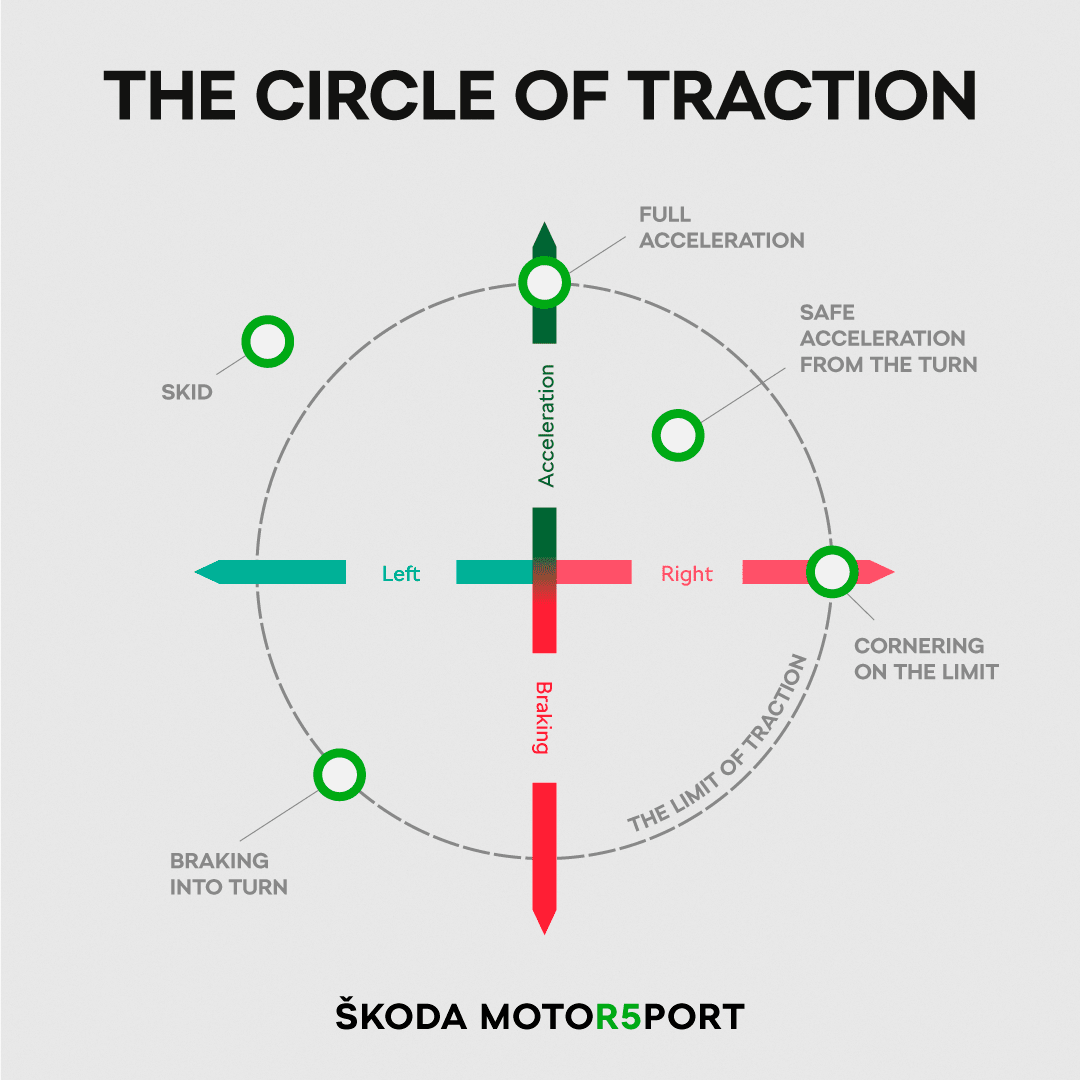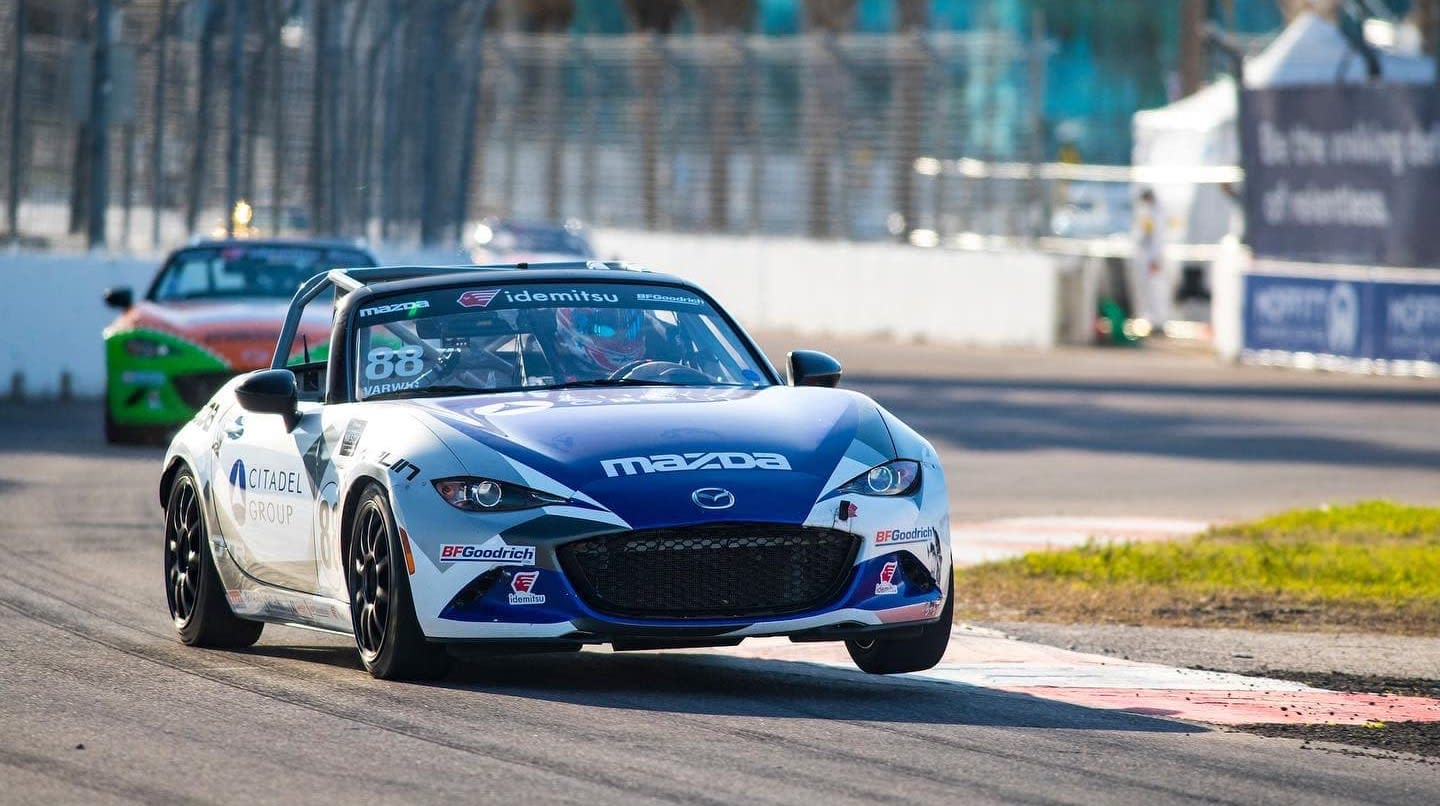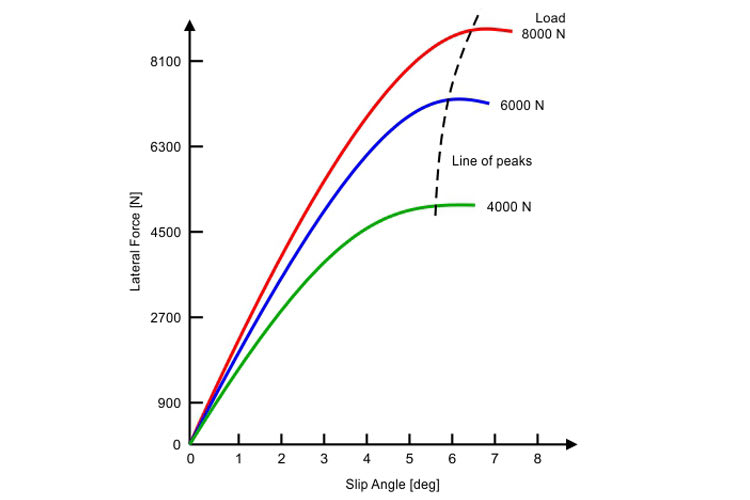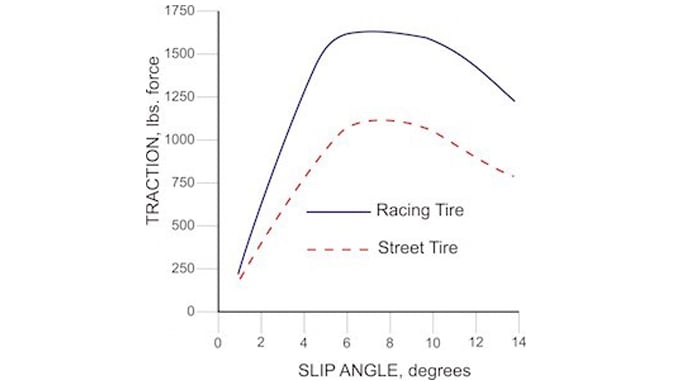In part 1, we covered that motorsport is about getting from one place to another as fast as possible[1]. This means achieving the highest velocities, which requires the highest accelerations, which in turn requires the highest forces. Those forces are all transmitted via your tires. So while it's not the only challenge, achieving (without exceeding!) the maximum forces your tires can deliver is at the heart of what makes motorsport hard.
My goal is to explain what is hard, where the challenge lies. To do that, I need to first cover some more of the physics.
Managing your traction budget
Tires have a maximum amount of force they can transmit[2]. It is a surprising and conveniently simplifying fact that a tire's ability to transmit force is roughly equal in all four directions (accelerating, decelerating, and turning). If the tire can exert a force of 1.2G, it can do it omnidirectionally[3].
That does not mean the tire can do 1.2G of acceleration in the forward direction and also 1.2G in the lateral direction. Instead, you've got a "budget" that has to be allocated between the different accelerations you might like to do. New drivers are always told to brake in a straight line: finish your braking, and then begin turning the car. Advanced drivers overlap these, which is advantageous for reasons I'll be able to explain soon. So you'll be splitting your 1.2G into 0.8G laterally and 0.4G forward, though adjusting the exact split as you go through any turn.
A capable driver who is driving at the limit is working to stay on the edge of the "traction circle". This requires careful coordination between your inputs (your steering, throttle, brake) so that you're not attempting to accelerate forward too much while at the same time turning too much, etc. If you get on the throttle too soon while coming out of a corner, you can lose traction. If you get on it too late, you lose to the other guy.

Balance, balance, balance.
It's time to talk about torque. I don't mean engine torque (the most important metric of engine performance following horsepower). No, I mean the torque operating over your entire vehicle anytime you accelerate.
Torques occur (rotational force) whenever a force is applied to a rigid body at some offset from a fulcrum / rotational center. Think about a car and the forces its tires transmit. The forces occur where the tires meet the road; however, that's not where the car's center of mass or center of rotation[4] is. So whenever a car is accelerating, braking, or turning, there is a force acting at its tires, not through its center of rotation, thereby exerting a torque on the car that wants to rotate it. Accelerate, and the car squats back. Brake and it dives forward. Turn hard, and the inside of the car rolls up and the outside down.

(Alternatively, this can be viewed through a centripetal forces lens.)
Why are high-performance cars so low to the ground? Granted, a lower car means less air underneath the car, pushing it up and reducing force on the tires. But crucially, the lower the car is to the ground, the closer the center of rotation/mass is to the bottom of the tires, the shorter the lever arm that's torquing the vehicle. Lower = less roll[5].
Does this all really matter? YES. I've said enough for you to extrapolate, so if you like puzzles, pause and think.
Take an object with a flat side, perhaps a rubber eraser, and attempt to push it along a table top by placing your finger or hand along the side. It moves. Now, simultaneously push the object down into the surface while also pushing it along. Much harder. The formula for frictional forces is , where N is the downward force.
Applied to our case, the force that tires can transmit depends on how much weight is on them[6]. More weight, more grip. (This is the point of "aero", e.g., spoiler/wings that convert drag into downforce, pushing the car into the road to get more grip[7].) But, as you accelerate the vehicle, you are rotating it, or equivalently, you are shifting the weight of the car between the wheels. Athletes in many sports are likely quite intentional about which leg their weight is on in any given moment. In motorsport, where the weight of the car is paramount.
When you are in the middle of a turn, not only are you using your traction budget for turning, but also your inside wheels have less weight on them and therefore less grip. Your inside (of the turn) drive wheel (i.e. back wheel for a rear-wheel drive) has less ability to "put down power" than the outside (of the turn) drive wheel.
There are multiple ways to lose traction and spin a car. A lot of them involve "upsetting the balance". Pictur a driver is slicing through a turn at speed, all four tires near their limit. They brake to slow the car. No problem, right? If 100km/h was within the limits, shouldn't 95km/h be too? No. Because when they hit the brakes, the car's weight is transferred to the front wheels and away from the rear wheels. With less weight on them, the rear wheels can no longer provide the same forces as before, and the car begins to spin.
A typical driver of the street is well beneath the limit. It doesn't matter if they brake mid-turn because there's enough traction budget for it. It's when you're at the limit that suddenly asking for a bit more takes you over that limit. The closer you are to the limit, the less tolerance, and the easier it is to lose your balance. Pro drivers are masters of balance.
The deep heart of the motorsport challenge
And so, really very deeply at the core of motorsport is managing weight transfer (that's the technical term). Via the inputs of throttle/brake/steering, the car is accelerated, and the acceleration shifts where the weight is, and where the weight is determines how much grip there is for a given tire.
Thereby, it becomes a constant balancing act. How fast can a driver turn the wheel to enter the corner? This is partly limited by the forces the tire can transmit, but it is also determined by how fast the car can transfer its weight. To take the corner at maximum speed, you want "load up the tires", and that takes a brief moment.
How long is the moment? Depends on the tires, but it also depends on your suspension. Suspension is the springs your car is suspended on. Soft springs will move a lot in response to forces, and take longer to do so. Race car drivers want their cars to respond quickly – shift their weight quickly – and that means they want stiff springs that don't move much and therefore transfer the car's weight very quickly. Stiff suspension means quick turn-in. It also means the weight transfer and rolling are less.
A pro driver is pro at balancing the car. They can sense where the tire's limit is, but also they get more out of the tires by placing the car's weight optimally over the wheels each moment, and getting the timing perfect on how long they give the car to respond to each input, not to mention the timing of when to brake/accelerate/turn.
Smooth is glue. Don't upset the car. That means don't jerk the car. A sharp turn would suddenly shift weight from one wheel to another, likely spiking the force requested from one over its limit. Cars like continuity ;)
Technique
What we've discussed above can be seen when examining various techniques used on the racetrack.
Trail Baking
I said earlier that new motorsport drivers are instructed to finish their braking, then begin turning. This is a waste. When you're braking, weight is transferred to the front wheels – the very wheels you use for turning! It's advantageous to have more weight, and therefore more grip, on the front wheels as you begin turning the car. Hence, advanced drivers trail break. They don't stop braking all at once, instead staying a little bit on the brakes (trailing) even as they begin to turn. The extra weight provides more grip at the front for turning.
Saving a spin
A driver is pushing a little too hard and exceeds what the rear tires can offer (let's imagine it was the start of a race and they weren't yet warm enough for maximum grip), the car begins to spin. Rather than let the car slow down, or even brake (gasp!) in the hopes of getting the car under control, instead the driver hits the throttle. Why would you hit the throttle mid-spin? Because it causes the car to shift weight rearward, onto the slipping tires, and helps them regain traction. It's not good advice for all cars, but for some: when in doubt, throttle out.
If you want to see me failing to save a spin induced by braking too hard, too late, while turning, see this video here:
Alas, this post has hit 1800 words, though I have not fulfilled the roadmap. Still owing is:
- Intentionally going over the limit in order to go faster
- Racecraft (the craft of racing)
- Engineering challenges / what makes a race car different
and really, it would be good to mention further skills such as vision, and probably elaboration on the finding the optimal line. A part 3, there shall have to be.
- ^
Or rather, faster than anybody else is able to. So you'd prefer a slower absolute time if that means you come in 1st over a faster absolute time and coming 2nd. This isn't theoretical. The defensive racing line is slower than the true fastest line when there are no other cars (typically called the "qualifying line").
- ^
More accurately tires have curves of "maximum force possible vs weight on the tire" and "maximum force vs angle between direction the tire is pointing and direction of travel (slip angle)" .
lateral force vs slip angle curves for a tire for different amounts of downward force - ^
Personally I found this to breaks down in the rain, where longitudinal grip is less affected than lateral grip.
- ^
Not quite the same thing but doesn't matter for here.
- ^
Less roll is better because for one thing, weight transfer is lossy. If you have 25/25/25/25 (total of 100) units of traction over the wheels and car turns, you might have 10/10/30/30 (total of 80). So less weight transfer is generally better.
- ^
Though don't think you can make a car faster by making it heavier. You will have more grip, but also more mass to accelerate!
- ^
An extremely cool electric race vehicle uses fans in the bottom of the car to suck it onto the road for insane grip.

